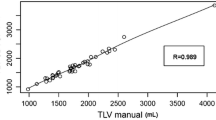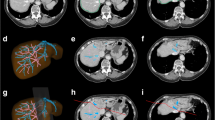Abstract
Major hepatectomy causes a risk of postoperative liver dysfunction, failure, and infections like surgical site infection. Preoperative assessment of the liver volume and function of the remnant liver is a mandatory prerequisite before performing such surgery. The aim of this work is to develop and test a software application for evaluation of the residual function of the liver prior to the intervention of the surgeons. For this purpose, a technique for evaluation of liver volume from computed tomography (CT) images has been developed. Furthermore, the methodology algorithms were implemented and incorporated within a software tool with three basic functionalities: volume determination based on segmentation of liver from CT images, virtual tumour resection and estimation of the residual liver function and 3D visualisation. Forty-one sets of abdominal CT images consisting of different number of tomographic slice images were used to test and evaluate the proposed approach. Volumes that were obtained after manual tracing by two surgeon experts showed a relative difference of 3.5 %. The suggested methodology was encapsulated within an application with user-friendly interface that allows surgeons interactively to perform virtual tumour resection, to evaluate the relative residual liver and render the final result. Thereby, it is a tool in the surgeons’ hands that significantly facilitates their duties, saves time, and allows them to objectively evaluate the situation and take the right decisions. At the same time, the tool appears to be appropriate educational instrument for virtual training of young surgeon specialists.







Similar content being viewed by others
References
Moreno Elola-Olaso A, Davenport DL, Hundley JC, Daily MF, Gedaly R: Predictors of surgical site infection after liver resection: a multicentre analysis using National Surgical Quality Improvement Program data. HPB (Oxford) 14:136–141, 2012
Schindl MJ, Redhead DN, Fearon KC, Garden OJ, Wigmore SJ: The value of residual liver volume as a predictor of hepatic dysfunction and infection after major liver resection. Gut 54:289–296, 2005
Guglielmi A, Ruzzenente A, Conci S, Valdegamberi A, Iacono C: How much remnant is enough in liver resection? Dig Surg 29:6–17, 2012
Tomoshige S, Oost E, Shimizu A, Watanabe H, Nawano S: A conditional statistical shape model with integrated error estimation of the conditions; Application to liver segmentation in non-contrast CT images. Med Image Anal 18:130–143, 2014
Heimann T, van Ginneken B, Styner MA, Arzhaeva Y, Aurich V, et al: Comparison and evaluation of methods for liver segmentation from CT datasets. IEEE Trans Med Imaging 28:1251–1265, 2009
Kumar S, Moni R: Diagnosis of liver tumor from CT images using countourlet transform. Int J Biomed Eng Technol 7:15, 2011
Liu F, Zhao B, Kijewski PK, Wang L, Schwartz LH: Liver segmentation for CT images using GVF snake. Med Phys 32:3699–3706, 2005
Lim SJ, Jeong YY, Ho YS: Automatic liver segmentation for volume measurement in CT images. J Vis Commun Image Represent 17:860–875, 2006
Goryawala M, Guillen MR, Cabrerizo M, Barreto A, Gulec S, et al: A 3-D liver segmentation method with parallel computing for selective internal radiation therapy. IEEE Trans Inf Technol Biomed 16:62–69, 2012
Goryawala M, Guillen MR, Gulec S, Barot T, Suthar R, et al: An accurate 3d liver segmentation method for selective internal radiation therapy using a modified k-means algorithm and parallel computing. Int J Innov Comput Inf Control 8:6515–6538, 2012
Ballard DH, Brown CM: Computer Vision, Prentice-Hall, 1982
Zanaty EA, Asaad A: Probabilistic region growing method for improving magnetic resonance image segmentation. Connect Sci 25:179–196, 2013
Ogiela MR, Hachaj T: The automatic two - step vessel lumen segmentation algorithm for carotid bifurcation analysis during perfusion examination, In: Smart Innov. Syst. Technol., Lakhmi C., Robert J., Junzo Toyohide, Phillips-Wren G.(eds), Vol 16: 485–493, 2012
Ogiela MR, Hachaj T: Automatic segmentation of the carotid artery bifurcation region with a region-growing approach. J Electronic Imaging 22: 2013
Mohd Saad N, Abu-Bakar SAR, Muda S, Mokji M, Abdullah AR: Fully automated region growing segmentation of brain lesion in diffusion-weighted MRI. IAENG Int J Comput Sci 39:155–164, 2012
Gasca F, Ramrath L, Huettmann G, Schweikard A: Automated segmentation of tissue structures in optical coherence tomography data. J Biomed Opt 14: 2009
Fadzil MHA, Izhar LI, Venkatachalam PA, Karunakar TVN: Extraction and reconstruction of retinal vasculature. J Med Eng Technol 31:435–442, 2007
Liu RM, Yang L, Liu E, Yang J, Li M, Wang F: Automatic extraction of infrared small target based on support vector regression and adaptive region growing algorithm. Opt Eng 46: 2007
Campadelli P, Casiraghi E, Esposito A: Liver segmentation from computed tomography scans: a survey and a new algorithm. Artif Intell Med 45:185–196, 2009
Wolf D: In: Walker HK, Hall WD, Hurst JW Eds. Clinical methods: the history, physical, and laboratory examinations: chapter 94: evaluation of the size, shape, and consistency of the liver, 3rd edition. Butterworths, Boston, 1990
Schneider W, Bortfeld T, Schlegel W: Correlation between CT numbers and tissue parameters needed for Monte Carlo simulations of clinical dose distributions. Phys Med Biol 45:459–478, 2000
Pons F, Varela M, Llovet JM: Staging systems in hepatocellular carcinoma. HPB (Oxford) 7:35–41, 2005
Author information
Authors and Affiliations
Corresponding author
Rights and permissions
About this article
Cite this article
Bliznakova, K., Kolev, N., Buliev, I. et al. Computer Aided Preoperative Evaluation of the Residual Liver Volume Using Computed Tomography Images. J Digit Imaging 28, 231–239 (2015). https://doi.org/10.1007/s10278-014-9737-5
Published:
Issue Date:
DOI: https://doi.org/10.1007/s10278-014-9737-5




